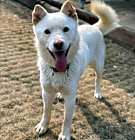The cost of a Samoyed can vary depending on factors such as the breeder’s reputation, pedigree, and location. On average, you can expect to pay between $1,000 to $3,000 for a Samoyed puppy from a reputable breeder.
Adopt A Samoyed
6 available Samoyeds near you

Deokgu
Samoyed Jindo
Male, 1 yr 3 mos
Torrance, CA
Good with dogs
Not good with cats
House-trained
Shots are up-to-date

DOBBY
Samoyed
Male, adult
Sierra Madre, CA
Not good with dogs
Not good with cats
House-trained
Spayed or Neutered

BOO
Samoyed
Female, young
Sierra Madre, CA
Not good with dogs
Not good with cats
House-trained
Spayed or Neutered

RYDEN
Samoyed
Male, adult
Sierra Madre, CA
Not good with dogs
Not good with cats
House-trained
Spayed or Neutered

BonBon
Samoyed
Male, young
Sierra Madre, CA
Good with dogs
Not good with cats
House-trained
Spayed or Neutered
Shots are up-to-date

STORM
Samoyed
Female, 4 yrs 6 mos
Sierra Madre, CA
Good with dogs
Not good with cats
House-trained
Spayed or Neutered
Shots are up-to-date
Search for Samoyed puppies and dogs
Find adoptable Samoyed by Beverly Hills, CA
Animal shelters near Beverly Hills, CA
Adopting a Samoyed
Frequently asked questions about acquiring an Samoyed - the pros and cons of adopting versus going through a breeder, and associated costs.
If you’re interested in adopting a Samoyed, you can start by checking local animal shelters or rescue organizations. Breed-specific rescues such as the Samoyed Rescue Alliance or local Samoyed rescue groups are also great places to look. Additionally, websites such as Petfinder or Adopt-a-Pet often have listings for Samoyeds in need of loving homes. Adopting a dog is a wonderful way to provide a second chance to a dog in need.


